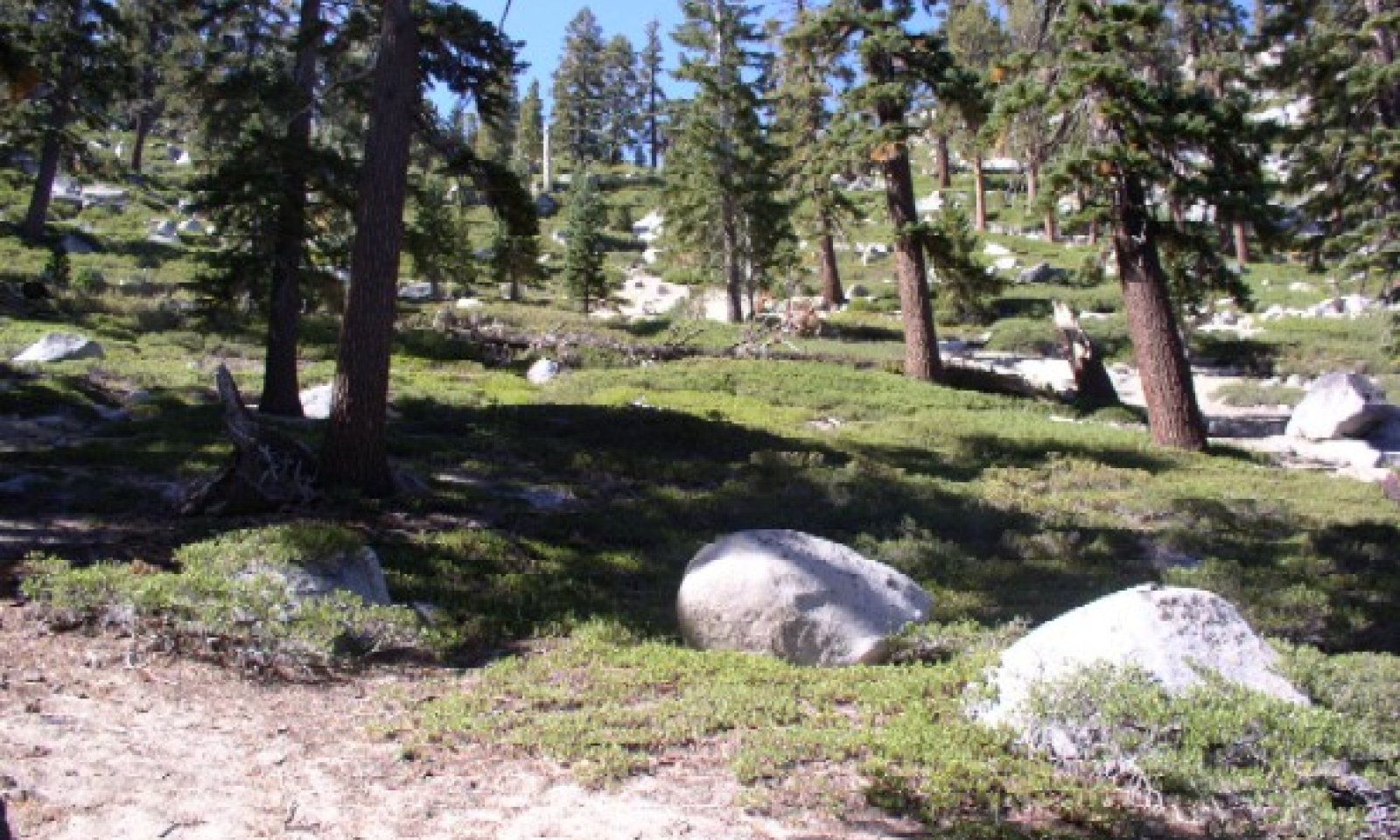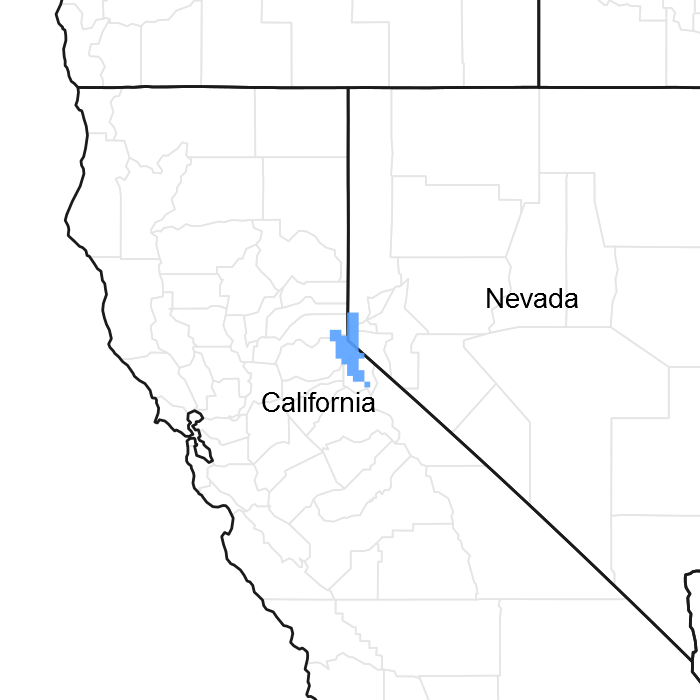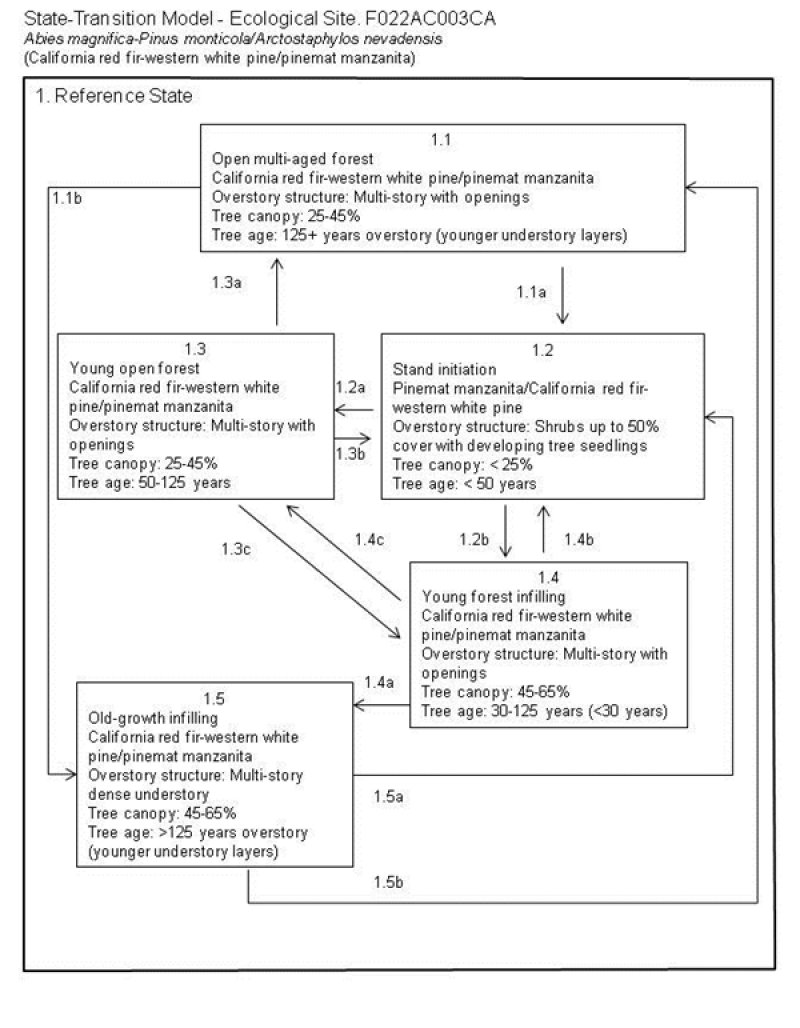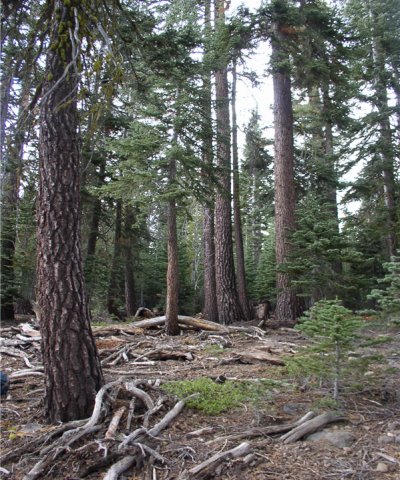

Natural Resources
Conservation Service
Ecological site F022AC003CA
Frigid-Cryic Sandy Slopes
Accessed: 01/30/2025
General information
Approved. An approved ecological site description has undergone quality control and quality assurance review. It contains a working state and transition model, enough information to identify the ecological site, and full documentation for all ecosystem states contained in the state and transition model.

Figure 1. Mapped extent
Areas shown in blue indicate the maximum mapped extent of this ecological site. Other ecological sites likely occur within the highlighted areas. It is also possible for this ecological site to occur outside of highlighted areas if detailed soil survey has not been completed or recently updated.
MLRA notes
Major Land Resource Area (MLRA): 022A–Sierra Nevada and Tehachapi Mountains
Major Land Resource Area 22A, Sierra Nevada Mountains, is located predominantly in California and a small section of western Nevada. The area lies completely within the Sierra Nevada Section of the Cascade-Sierra Mountains Province. The Sierra Nevada range has a gentle western slope, and a very abrupt eastern slope. The Sierra Nevada consists of hilly to steep mountains and occasional flatter mountain valleys. Elevation ranges between 1,500 and 9,000 ft throughout most of the range, but peaks often exceed 12,000 ft. The highest point in the continental US occurs in this MLRA (Mount Whitney, 14,494 ft). Most of the Sierra Nevada is dominated by granitic rock of the Mesozoic age, known as the Sierra Nevada Batholith. The northern half is flanked on the west by a metamorphic belt, which consists of highly metamorphosed sedimentary and volcanic rocks. Additionally, glacial activity of the Pleistocene has played a major role in shaping Sierra Nevada features, including cirques, arêtes, and glacial deposits and moraines. Average annual precipitation ranges from 20 to 80 inches in most of the area, with increases along elevational and south-north gradients. Soil temperature regime ranges from mesic, frigid, and cryic. Due to the extreme elevational range found within this MLRA, Land Resource Units (LRUs) were designated to group the MLRA into similar land units.
LRU "C" Northern Sierra Subalpine: Elevations are typically between 7,800 and 9,800 feet. The frost free period is between 30 and 90 days, MAAT is between 35 and 44 degrees, MAP is between 45 and 65 inches. Soils are typically cryic, but frigid soils may occur at lower elevations on southern aspects. Forests are dominated by whitebark pine (Pinus albicaulis), Sierra lodgepole pine (Pinus contorta spp. murrayana), mountain hemlock (Tsuga mertensiana) and/or California red fir (Abies magnifica).
Classification relationships
Forest Alliance = Abies magnifica – California red fir forest; Association = tentatively Abies magnifica-Pinus monticola/Arctostaphylos nevadensis. (Sawyer, John O., Keeler-Wolf, Todd, and Evens, Julie M. 2009. A Manual of California Vegetation. 2nd ed. California Native Plant Society Press. Sacramento, California.)
Ecological site concept
This site occurs on gentle to steep mountain slopes with moderately to very deep poorly developed gravelly coarse sandy soils over decomposed granite. It occurs at the lower elevations of the subalpine LRU, typically between 7600 and 9000 feet, where soils may have a cryic or frigid temperature regime. Slopes are typically between 15 and 50 percent. The vegetation is mixed upper montane forest, dominated by red fir (Abies magnifica) and western white pine (Pinus monticola). Pinemat manzanita (Arctostaphylos nevadensis) is common in the canopy openings in the understory. California red fir is a slow-growing, long-lived tree that has high frost tolerance and low drought tolerance, and reaches dominance only in cooler and moister upper elevation. Pinemat manzanita is indicative of cold, dry sites.
Associated sites
| F022AC001CA |
Cryic Sandy Mountain Slopes Occurs on adjacent higher elevation slopes at or near treeline with shallow to moderately deep, sandy skeletal soils over decomposed granite. Vegetation is a whitebark pine (Pinus albicaulis) forest with very little understory |
|---|---|
| F022AC002CA |
Cryic Sandy North Apsect Mountain Slopes Occurs on north-facing slopes at or near treeline. Vegetation is a whitebark pine (Pinus albicaulis) - mountain hemlock (Tsuga mertensiana) forest with very little understory. |
| F022AC006CA |
Moderately Deep Cryic Sandy Till Occurs on adjacent south-facing moderately deep, loamy-skeletal soils over dense till, primarily from volcanic parent material.Vegetation is an open lodgepole pine forest (Pinus contorta var. murrayana) with red fir (Abies magnifica) and western white pine (Pinus monticola). |
| F022AC007CA |
North-Facing Cryic Loamy Mountain Slopes Occurs on adjacent north-facing slopes with moderately deep andic soils. Vegetation is subalpine mixed conifer forest with mountain hemlock (Tsuga mertensiana), red fir (Abies magnifica), western white pine (Pinus monticola), and occassionally lodgepole pine (Pinus contorta var. murrayana). |
| F022AE007CA |
Frigid, Sandy, Moraines And Hill Slopes Occurs on adjacent moraines and moderately sloping hills with sandy soils derived from glacial outwash and till from mixed parent materials. Vegetation is a productive Jeffrey pine (Pinus jeffreyi) - white fir (Abies concolor) forest. |
| F022AF004CA |
Frigid, Shallow To Deep, Sandy Mountain Slopes Occurs on lower elevation slopes with moderately to very deep sandy soils. Vegetation is open Jeffrey pine (Pinus jeffreyi) forest with high shrub cover. |
| F022AX100CA |
Frigid, Sandy, Moist, Outwash Fan Occurs on adjacent very deep, poorly drained soils that formed in alluvium from glacial outwash fans. The vegetation is a Sierra lodgepole pine (Pinus contorta var. murrayana) forest with willows and forbs. |
| F022AX101CA |
Moist Colluvial Headwater System Occurs on adjacent headwater swales and first order streams. A complex of vegetation community types is present, and quaking aspen (Populus tremuloides) is a characteristic species. |
Similar sites
| F022AC006CA |
Moderately Deep Cryic Sandy Till This site is found on south-facing slopes with moderately deep loamy-skeletal soils over dense till, primarily from volcanic parent material. The dense till acts as a root restrictive layer that perches water for a short period.Sierra lodegepole pine (Pinus contorta var. murrayana) dominates and red fir (Abies magnifica) and western white pine (Pinus monticola) are secondary species. |
|---|---|
| F022AC007CA |
North-Facing Cryic Loamy Mountain Slopes This is a moister site that occurs on north-facing slopes with moderately deep skeletal, andic soils. Mountain hemlock (Tsuga mertensiana) and Sierra lodgepole pine (Pinus contorta var. murrayana) are important canopy species with red fir (Abies magnfica) and western white pine (Pinus monticola). |
| F022AC004CA |
Cryic Very Gravelly Loamy Mountain Slopes Site occurs on soils developed from metamorphic parent material that have loamy and silty clay loam subsurface textures, with argillic horizons. Jeffrey pine (Pinus jeffreyi) is co-dominant with red fir (Abies magnifica), and a dense shrub layer of roundleaf snowberry (Symphoricarpos rotundifolius) and wax currant (Ribes cereum) is present. |
| F022AC008CA |
Cryic Volcanic Mountain Slopes This site is found on very deep soils derived from andesitic bedrock. Soils are more developed, and have argillic horizons. White fir (Abies concolor) is co-dominant with red fir (Abies magnifica), and shrub diversity and production is higher. Greenleaf manzanita (Arctostaphylos patula) and whitethorn ceanothus (Ceanothus cordulatus) are common shrub species. |
Table 1. Dominant plant species
| Tree |
(1) Abies magnifica |
|---|---|
| Shrub |
(1) Arctostaphylos nevadensis |
| Herbaceous |
Not specified |
Click on box and path labels to scroll to the respective text.


